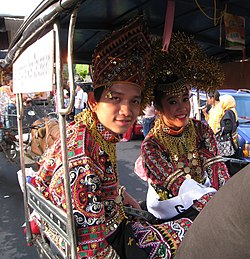This article needs additional citations for verification .(October 2011) |
Urang Gayo | |
|---|---|
 A Gayonese couple in traditional attire. | |
| Total population | |
| 336,856 [1] | |
| Regions with significant populations | |
| Languages | |
| Gayo, Acehnese, and Indonesian | |
| Religion | |
| Sunni Islam | |
| Related ethnic groups | |
| Alas • Karo • Acehnese |
The Gayo people (Gayo: Urang Gayo; Indonesian: Orang Gayo) are an Austronesian ethnic group living in the highlands (primarily Gayo Lues) of the province of Aceh, Sumatra, Indonesia. The Gayo people has a population of 336,856 and they live predominantly in the mountains. Most of them live in three regencies in Aceh, namely Bener Meriah, Central Aceh, and Gayo Lues. Some of them live in several districts in other regencies, such as Serbajadi, Simpang Jernih, Peunaron, and Birem Bayeun in East Aceh, Beutong and Beutong Ateuh Banggalang in Nagan Raya, and Cot Girek in North Aceh. Other than that, the Gayo population also covers Southeast Aceh Regency and Aceh Tamiang Regency. [2] Their homeland lies in the Barisan Mountains which has elevations of over 12,000 feet and extends more than one thousand miles. The Gayo language has five dialects: Bukit, Dëret, Lues, Lut, and Serbejadi-Lukup. Their language does not have a writing system, but folk tales, stories and poetry are passed down in oral tradition. The traditional house of the Gayo is called umah.




